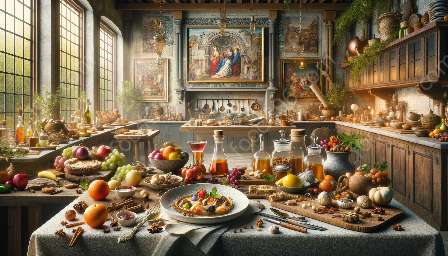The Renaissance era was an exciting time for the evolution of cuisine, characterized by its use of a wide variety of ingredients and the exploration of new flavors and cooking techniques. This topic cluster will provide a comprehensive look at the ingredients that shaped Renaissance cuisine, their historical significance, and their impact on culinary traditions.
Renaissance Cuisine History
The Renaissance, a cultural and artistic movement that spanned the 14th to the 17th century in Europe, also greatly influenced the culinary world. This period saw the revival of interest in classical learning, which led to advancements in science, art, and culinary arts. Renaissance cuisine was marked by a shift towards a more refined and artistic approach to food preparation, an increased use of spices and exotic ingredients, and the development of new cooking methods. The resultant cuisine reflected the social and economic changes of the time.
Cuisine History
Before delving into the specific ingredients used in Renaissance cuisine, it is essential to understand the broader history of cuisine and its impact on the development of culinary traditions. Throughout human history, food and cooking have been integral to societies, shaping cultural identities, trade, and social interactions. Each era and civilization have contributed to the rich tapestry of global cuisine, laying the foundations for the culinary diversity we experience today.
Exploring Ingredients in Renaissance Cuisine
The ingredients used in Renaissance cuisine were diverse and reflected the period's exploration and trade with distant lands. These ingredients included spices, herbs, meats, fruits, vegetables, and grains. Let's delve into the key ingredients that were integral to Renaissance cuisine:
1. Spices and Herbs
Spices and herbs were highly prized in Renaissance cuisine, not only for their ability to enhance flavors but also for their medicinal properties. The spice trade with the East brought a variety of exotic spices such as cinnamon, nutmeg, cloves, and pepper which were used to flavor both sweet and savory dishes. Herbs like parsley, sage, rosemary, and thyme were also prevalent in Renaissance cooking, adding depth and fragrance to dishes.
2. Meats
Meats played a central role in Renaissance cuisine, particularly for the noble and wealthy classes. Game meats such as venison, wild boar, and pheasant were popular choices, as were domestic meats like beef, pork, and lamb. The meats were often prepared in elaborate ways, such as roasting or braising, and were often seasoned with a variety of spices and herbs.
3. Fruits and Vegetables
Renaissance cuisine embraced a wide array of fruits and vegetables, many of which were introduced from the New World. Fruits like apples, pears, and plums were commonly used in both savory and sweet dishes. Vegetables such as carrots, parsnips, cabbage, and turnips were staples in many recipes and were often cooked with meats or transformed into hearty soups and stews.
4. Grains
Grains formed the foundation of many Renaissance dishes, particularly in the form of bread and pasta. Wheat and rye were the most commonly used grains to make bread, which was a staple in the Renaissance diet. Additionally, pasta, in various forms, made its way into Italian Renaissance cuisine, contributing to the rich and diverse culinary landscape of the era.
Impact on Culinary Traditions
The ingredients used in Renaissance cuisine had a lasting impact on culinary traditions, influencing subsequent eras and global cuisines. The introduction of new ingredients from the New World, advancements in culinary techniques, and the blending of flavors from diverse regions all contributed to the evolution of modern cooking.
In conclusion, the exploration of ingredients used in Renaissance cuisine offers a fascinating glimpse into the culinary heritage of this period. The era's emphasis on exotic spices, rich meats, flavorful fruits and vegetables, and essential grains laid the groundwork for the diverse and vibrant culinary traditions that continue to shape our dining experiences today.

